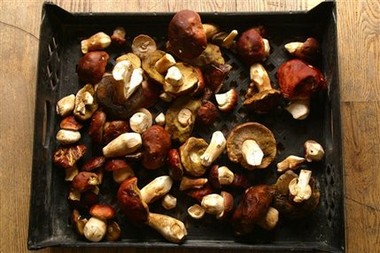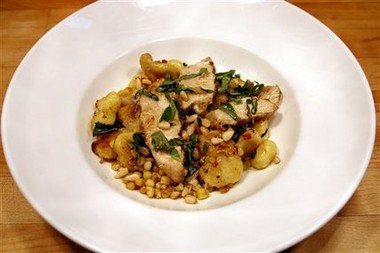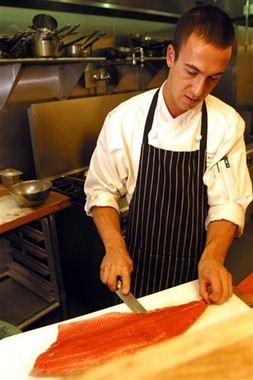Westward, chow!
September 17, 2007 - ASAP / Associated Press

JACKSON HOLE, Wyo.
Type “American regional dishes” into Google, and the first thing that comes up is a page for Linda Stradley’s cookbook, “I’ll Have What They’re Having—Legendary Local Cuisine.”
New England is represented by the photo of a Whoopie Pie. There are boiled peanuts for the “Deep South.”
Hawaii displays a photo of an egg, beef and gravy artery-clogger called Loco Moco.
 A plate of gnocchi, chicken, sweet corn and basil, just before being served at The Kitchen in Boulder, Colo. With an emphasis on freshness, quality and simplicity, food like this is beginning to give a good name to the food of the West. (AP Photo/Joe Ray)
A plate of gnocchi, chicken, sweet corn and basil, just before being served at The Kitchen in Boulder, Colo. With an emphasis on freshness, quality and simplicity, food like this is beginning to give a good name to the food of the West. (AP Photo/Joe Ray)The “Rocky Mountains” box, however, looks like slot for the kid who didn’t show for his yearbook photo. There’s no picture and no food.
For years, the idea of “the food of the West” was akin to baked beans being served along a tumbleweed-strewn dirt road in a one-horse town. Fear not. Times have changed, and though you might pay a bit more for the privilege of eating well out here, you’ll be pleasantly surprised with what you find.
“When you think about the West, (the food) wasn’t what people came out here for,” agrees journeyman chef Richard Bellingham, who recently opened the North Grille restaurant in Jackson Hole.
He’s got a point. Famous western icons include mountains, cowboys, snow bunnies and hikers. But traditionally, food hasn’t made the cut.
Food experiences in and around Jackson tend to be burgers joints and cowboy reviews, like the famous Bar J Chuckwagon, where well-done steak and potatoes can be served on tin plates to 700 hungry tourists in an impressive 25 minutes.
“You can do the chuckwagons,” says Bellingham, stressing that even he likes going to from time to time, “but I said a long time ago that I like to bastardize stuff to my tastes.”
Billingham’s “bastardized” offerings counters round-‘em-up fare with plates like a baked Maytag blue cheese “parcel,” with red onion marmalade and crispy veal sweetbreads over fried grits with maple-cured bacon cream. It’s taken over 20 years for this kind of change to make it out here.
 Dakota Soifer skins salmon that will later be wood-roasted and served with a pesto couscous at The Kitchen (upstairs), in Boulder, Colo.(AP Photo/Joe Ray)
Dakota Soifer skins salmon that will later be wood-roasted and served with a pesto couscous at The Kitchen (upstairs), in Boulder, Colo.(AP Photo/Joe Ray)“There wasn’t much going on,” says chef Roger Freedman of the Rendezvous Bistro, reflecting on the change he’s seen in his 14 years in this resort town. “Now, we’ve got farmers in Idaho who will ask chefs what they want.”
As the quality and reputation of western food slowly grew, more and more chefs came from around the country and across the globe, each bringing their own cooking style to the table.
“I came from L.A.,” says a grinning Freedman, “I had to get out.”
This mix can lead to a bit of a culinary hodgepodge, but it also has common points that are now beginning to define western cuisine: seasonality, going local whenever possible, creativity and winks to the past.
Chez Freedman, who got his start in Jackson Hole as the founding chef at the landmark Snake River Grill, this could mean anything from classic French-style steak frites to grilled Idaho trout with a jicama carrot slaw and orange chipotle glaze.
Using fresh and local foods—items that haven’t always been an option—has become one of the keys to understanding what’s going on out West. Chefs worth their salt will build menus around these items, and though sushi in the landlocked west sounds as appetizing as salmonella on a stick, they round out their offerings by shipping in what they can’t get locally.
___
STANDING THE HEAT
Down in Boulder, Colo., all the pieces come together at The Kitchen and its sister restaurant, The Kitchen (upstairs). I spend an afternoon in the Kitchen’s kitchen, watching lunch chef Gavin Leigh run the show, as plate after plate of good-looking grub goes out to the trendy restaurant’s floor.
“Can I have some hands?” calls out the U.K. native, using curious in-house lingo for an order pickup; I give him a funny look and the well-traveled chef replies, “I’d never heard of it either.”
In the meantime, he slips me a bite of a hand-cut gnocchi which melts in my mouth like a delicate, fresh-made cheese. Served with chicken, sweet corn and basil, it screams freshness, quality and simplicity.
“You don’t need to do a lot with the food when it’s this good,” he says, referring to the quality of their purveyors. Many of their other plates are similar, minimalist delights counting heavily on product seasonality.
“You can get halibut year-round,” chimes in (upstairs) chef Dakota Soifer, “but it’s not right.”
“We’re able to cook whatever we get and we don’t freak out because there’s no eggplant,” adds Leigh.
“Plus,” says Soifer, “Our boss is about to come back with a sack of mushrooms.”
On cue, Kitchen chef/proprietor Hugo Matheson shows up from a local mushroom hunting excursion with several giant trays of porcinis.
“There is no ‘food of the West,’” says a suddenly reflective Leigh, who then has a mid-sentence change of heart. “The food of the West is being created now.”
___
Paris-based food and travel writer Joe Ray is now hunting for stories about grass-fed beef in Chile and Argentina. He can be reached via his Web site, joe-ray.com.